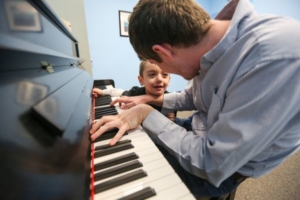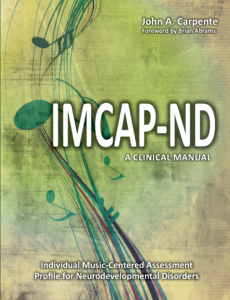 Hi folks,
Hi folks,
An ongoing key topic when discussing behavioral and developmental approaches is the concept of following the client’s lead. This is especially relevant within the current trends in the research pertaining to evidence-based practice in regards to interventions with children with autism spectrum disorder (ASD). Yes, that’s correct, developmental interventions are considered evidence based research. Moreover, even the current behavioral research shows to be using developmental interventions in their treatment protocols. Unfortunately, most clinicians continue to quote out dated research when speaking on evidence-based practice. All of that being said, the topic of client-led interactions, which is at the core of developmental interventions, is extremely relevant and draws quite a bit of discussion in terms of what it is and isn’t.
Client-led interactions, or better known as following the child’s lead, is at the core of developmental relationship-based work and in music therapy, it may involve the therapist creating musical experiences based on the client’s musical responses, behaviors and/or emotionality e.g., musically reflecting their emotional state, creating music around their musical and/or non-musical action, etc. Some therapists, however, feel that following the client’s lead means to ONLY and ALWAYS follow what the client is doing whereby never implementing any boundaries, limits or challenges. Tis is not. Others may say, “follow the client’s lead only when it’s appropriate.” Appropriate? Appropriate to what? Finally, some say, you can not and should not follow the client’s lead until he/she learns appropriate behavior skills.” Personally, I’m not sure about that- Seems to be a bit backwards!
When following the client’s lead, a term coined by the late Dr. Stanley Greenspan, we are seeking to gain a glimpse into the emotional world of the client. What are their interests? What do they like? dislike? preferences? tendencies? strengths and challenges? What are the musical and extra-musical conditions that the client may need in order to maintain engagement, relatedness, and communication (core deficits of ASD)? when does the client withdraw from engagement and relatedness? How do they break-off engagement and relatedness? Why do they break-off engagement and relatedness? How can we contextualize their individual-differences (biological challenges) that interfere with the client’s ability to relate an communicate. By following the client’s leads and providing them with musical experiences based on their musical or non-musical presence, the above qualities may manifest in music during the session. In turn, this informs the therapist’s music as well as the supportive intervention strategies that are indicated. If we simply focus on behaviors, we will never understand the bigger questions that may be holding the client back from developing and engaging with essential interactions. In addition, how else can we observe and hear the client’s actions, if we are solely imposing our own ideas of what the client “should” be doing?

One of the most important aspects regarding following the client’s lead is to develop and foster relationship. The relationship is crucial. It is in the relationship, and the experience of being related, where the therapy and learning grows and mingles. It also provides the pathway to informing the therapist’s music and techniques. Learning through and in relationship is extremely important, however, it poses a great deal of responsibility onto the therapist in terms of him/her understanding how to provide learning or therapeutic experiences within the dynamic of the relationship.
Another important element of following the client’s lead is the therapists’s ability to understand when and how to implement techniques that maneuver the interaction to where it becomes therapist lead. Thus, when the interaction shifts and becomes therapist-led, the client is now following the therapist lead. Once this occurs, and the client responds in a related a communicative manner, we now have reciprocity. We also have a circle of communication, in which 2 individuals are equally engaged in a back-and-forth dialogue. In addition, we see here shared problem-solving, adaption, and joint attention as the client spontaneously responds to the therapist’s interaction. Furthermore, the client has now shown not only his ability to respond to joint attention, but also to initiate joint attention. Finally, the client here is displaying his/her ability to open and close circles of communication in a related manner. This is functional communication whether being verbal or non-verbal e.g., musical, gestural, etc. Thus, the idea here, is yes, we follow the client’s lead, however, we then need to follow the opportunity for the interaction to be therapist-led, then back to client-led, and so on. After all, to function outside of music therapy, the client will need to develop the ability to navigate and manage their ability to initiate, follow, and adapt to others in everyday life. Thus, following the client’s lead is the necessary ingredient that will guide the interaction into a synchronous dance between client- and therapist-led interactions.
How does the client ever develop the ability to initiate if they are not encouraged to exercise their own ideas, desires, and thoughts? How does a client develop higher levels of thinking, such as abstraction and empathy if the basis for their interactions have nothing to do with experiencing a range of emotion through contextualized relationship-based interactions? How will the client develop the ability to read facial cues (pre-verbal development) that are directly tied into the emotionality of the cue? How can one develop in an artificially driven environment that is soley based on stimulus-responses interactions?
During my IMCAP-ND trainings and presentations, a common question that comes up is: ” is following the client’s lead” a specific technique or intervention used only when working with children?” The answer is “no, it is not.” Following the client’s lead is simply a way of thinking, working, and being with client’s regardless of their challenges and age. Clients needs, challenges, strengths, and differences vary across client groups, however, respecting and being with clients in-the-moment in a “reciprocal” and relationship-based manner can be applied across all client groups.
The following is an excerpt from the IMCAP-ND describing “following the client’s lead.” (Carpente, 2013, p.13):

Following the client’s lead is a Floortime™ technique (Greenspan, 1992; Greenspan & Weider, 2006a, 2006b) that refers to the therapist following the client’s natural emotional interests while at the same time challenging him/her socially, emotionally, and intellectually. Greenspan (1992) explains that by focusing on the client’s interests while following his/her lead, the therapist is invited into the client’s emotional life (1992). Thus, by following a client’s natural desires, the therapist can begin to understand what the client finds enjoyable and pleasurable (Greenspan & Weider, 2006a, 2006b). Musically, this is no different. By following the client’s musical emotional lead, the therapist can begin to understand the client musically in terms of his/her musical tendencies, preferred choice of musical media, and the overall types of musical experiences (e.g., styles, idioms, contexts, etc.) that he/she finds pleasurable.
Nordoff and Robbins (2007) referred to the same phase in their work with children with special needs. They called the phase “meeting the client musically,” in which musical engagement begins with matching the client’s emotional “being” or state with the music. Thus, the therapist improvises music that accepts and meets the client, musically, and in doing so opens a channel of communication (Aigen, 2005; Nordoff & Robbins, 2007).
The aims of this phase are to build rapport with the client by creating an accepting musical environment that is respectful of his/her reactions and responses; this will help the therapist to discover the client’s musical tendencies, preferences, sensitivities, and preferred musical media and discern what the client finds pleasurable and unpleasant in musical-play.
Following the client’s musical-emotional lead begins by observing and listening to his/her reactions, responses, and initiated behaviors. During this phase the therapist is seeking out clues and cues that will inform the musical direction of the interaction. Thus, the therapist is watching and listening to how the client: a) separates from his/her parents or caregiver, b) enters into the room, and c) is experiencing the musical environment and situation. Prior to the therapist playing and/or singing a note, he/she may begin to conceptualize the client musically and begin planning a framework for a musical experience based on observable and/or audible responses and reactions. The therapist may initially focus on the client’s awareness of tempo, rhythm, and pace of motor movements (e.g., walking, pacing, running, jumping, utilization of the instruments, etc.) while being attentive to any vocal sounds being expressed (reflexive and/or intentional). In addition, the therapist at the same time is observing which instrument the client is drawn to and the manner in which client approaches, handles, and/or plays the instrument.
In this work phase the therapist is being attentive to the client’s emotional climate as well as his/her ability to process the sensory information in the environment while seeking to answer questions such as (Carpente, 2013):
- Is the client self-directed?
- Does the client maneuver with a look of fear and/or ambivalence?
- How does the client physically (motor) and perceptually maneuver around the room?
- Does the client present with no fear?
- Does the client display awareness to physical and interpersonal boundaries?
- Does the client move repeatedly from one instrument to the next?
- Does the client display an interest in any of the instruments, music, and/or therapist?
- Is the client’s interest in the instruments motivated by sensory or musical desires?
- Does the client handle and play the instruments with their intended purpose?
- What is the client’s overall reactivity level (i.e., hypo, hyper, or mixed) during the musical experience?
- Is the client approachable musically and/or interpersonally?
- What are the client’s musical tendencies and preferences in terms of musical style, idioms, elements, form, and context?
Musically, the therapist follows the client’s lead (based on clinical observation and listening) by improvising music that meets or matches the client’s affect while accompanying, reflecting, synchronizing, and/or enhancing any musical and nonmusical responses and reactions that the client may be expressing. All client responses and reactions, including idiosyncratic perseverative behaviors, are viewed and heard as communicative and are conceptualized within a musical context. Thus, the therapist musically responds to the client’s moment-to-moment responses or behaviors, while consistently matching his/her affect as means of acceptance.
If you’re interested in learning more about this type of work, check out our online or in-person training course, Developmental Relationship Music Therapy 101 course
Thanks for reading and please feel free to comment!
Best,
John
